1. Meaning:
Three
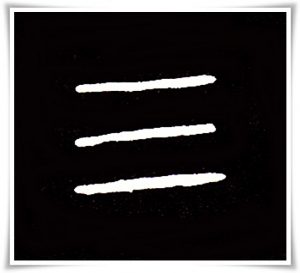
2. Readings:
- Kunyomi (訓読み): み, みっ.つ, み.つ
- Onyomi (音読み):サン, ゾウ
- Japanese names: か, さ, さい, さえ, さぶ, ざ, ざえ, ざぶ, そう, ぞ, ただ, みつ, みん, も, や
- Chinese reading: sān
3. Etymology
三 belongs to the 指事文字 (しじもじ, shijimoji, i.e. set of characters expressing simple abstract concepts). 三 imitates the shape of three long and thin objects, such as small twigs used as an ancient calculation method. It is not a pictograph of three extended fingers, as many sources erroneously suggest.
Researching the etymology of 三 I realised how much in common it has with my wife. Such a tiny and inconspicuous phenomena, but what a character!
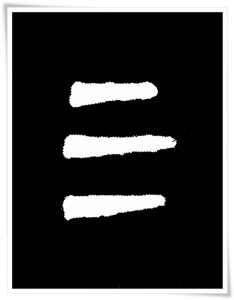
In Shuowen Jiezi (說文解字, pinyin: Shūowén Jiězì, i.e. “Explaining Simple [Characters] and Analyzing Compound Characters”) from the 2nd century C.E., compiled by Xu Shjen (許慎, pinyin: Xǔ Shèn, ca. 58 C.E. – ca. 147 C.E.), a philologist of the Han dynasty (漢朝, 206 B.C. – 220 C.E.) we read: “數名。天地人之道也。” (pinyin: shǔ míng. Tiān dì rén zhī dào yě), i.e. “三 is a number. A principle (reasoning) of Heaven Earth and Man”. 天地人 are known as San Cai (三才, pinyin: Sān Cái, i.e. “All Three Powers, i.e. Heaven, Earth and Man”, respectively), also known as Three Extremes (三極, pinyin: sān jí), where 三 stands for 天 (Heaven), 地 (Earth)and 人 (Man), and 才 symbolizes the dynamics ruling those three phenomena. Three then, is a divinatory number, which is hardly surprising as all other numbers are imbued with magical meanings (see here the article on the etymology of the character 九 (きゅう, kyū, i.e. “nine”).
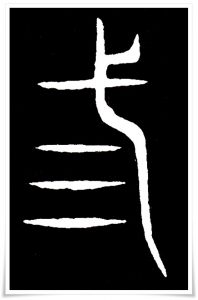
三 is also closely related to the divinatory system of 64 hexagrams, introduced in the Book of Changes, also known as Five Classics (易経, pinyin: Yì jīng) whose original text was written on bamboo slips around the mid-3rd century B.C. It is one of the oldest Chinese classics in existence. To read more regarding the Book of Changes and its relation to Chinese characters, please refer to the article on the etymology of the character 校 (こう, kō, correction; exam; printing; proof; school; archaic: assemble, join [wood], etc.)
In Lao Tsu’s (老子, Lǎo Zǐ, ca. 500B.C.) Dao De Jing (道徳経, pinyin: Dào dé jīng), chapter 42, we find the following passage: “道生一。一生二。二生三。三生萬物。萬物負陰而抱陽,沖氣以為和。” (pinyin: Dào shēng yī. Yīshēng èr. Èr shēng sān. Sān shēng wànwù. Wànwù fù yīn ér bào yáng. Chōng qì yǐwéi hé.) It means: “The Dao (Tao) begot one (一). One begot two (二). Two begot all living things (三). All living things bear the element Yin (陰, Chinese: yīn) and embrace the element Yang (陽, Chinese: yáng). Harmony is achieved by the combination of all natures”.
The above clearly proves that 三 cannot be a character of pictographic origin, rather, it is a representation of a complex concept which reaches deep into the occult and divinatory beliefs of the ancient Chinese people.
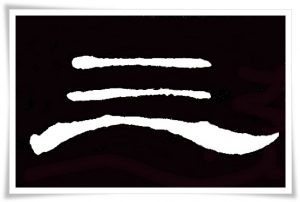
To further delve into the meaning of 三, I call your attention to the etymology of the character 王 (おう, ō, i.e. “king”, “ruler”). According to the work of philosopher Dong Zhongshu (董仲舒, Dǒng Zhòngshū, 179-104 B.C.) of the early Han dynasty (漢朝, 206 B.C. – 220 C.E.), titled Chunqiu Fanlu (春秋繁露, pinyin: Chūnqiū Fánlù, i.e. “Rich Dew of Spring and Autumn [period]”), the shape of the character 王 has a symbolic meaning. The Three Powers (三才) symbolized by three horizontal lines are connected by one vertical stroke, an allegory of the unification of those powers and the taking control over them by a ruler.
A given Chinese character may have myriad forms, and they often differ significantly from one another. On the other hand, a few different characters (of separate etymology) may bear identical meaning.
There are more kanji with the same meaning as 三. The archaic form (so called kobun (古文, こぶん, i.e. “ancient writing”, found in Shang (商朝, 1600 – 1046 B.C.) and early Zhou dynasty texts) of 三 is 弎, and it is its traditional form (正字, せいじ, seiji, lit “proper character”). The character 参, which has two further variants: 參 and 叅, has the same reading (and meaning) as 三 or 弎, and it is used in legal documents. Please note that 参 has a completely different etymology than 三, thus it is not a kanji variant (異体字, いたいじ, itaiji) of 三. (Please also see the article on the etymology of the character 一 (いち, ichi, i.e. “one”, of which the archaic form is 弌).
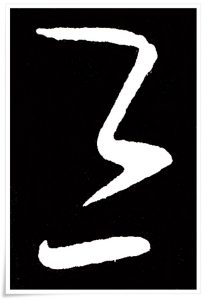
4. Selected historical forms of 三.
Figure 1. Kobun (古文, こぶん, i.e. “ancient form”) of 三. Oracle bone script (甲骨文, こうこつぶん, kōkotsubun) from ca. 1600 B.C.
Figure 2. Ink rubbing of kinbun (金文, きんぶん, i.e. “text on metal”)form of the character 三, found on one of the bronze vessel named Yu Ding (盂鼎, pinyin: Yú Dǐng), which was cast during the Western Zhou dynasty (西周, 1027 – 771 B.C.).
Figure 2.2. Ink rubbing of the great seal script (大篆, だいてん, daiten)of the archaic form of the character 三, i.e. 弎, found in the Shuowen Jiezi (說文解字, pinyin: Shūowén jiězì, i.e. “Explaining Simple [Characters] and Analyzing Compound Characters”) from the 2nd century C.E., compiled by Xu Shen (許慎, Xǔ Shèn, ca. 58 C.E. – ca. 147 C.E.), a philologist of the Han dynasty, found under a section entitled Guwen (古文, pinyin: gǔwén) devoted to the character forms from the Warring States period (戰國時代, pinyin: Zhànguó shídài, 475 – 221 B.C.).
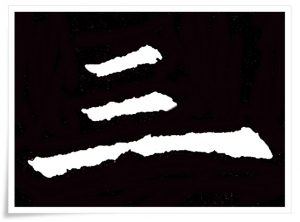
Figure 3. Ink rubbing of the clerical script form (隷書, れいしょ), form of the character 三 found on the stele Cao Quan (曹全碑, pinyin: Cáo quán bēi), Han dynasty (漢朝, 206 B.C. – 220 C.E.), 185 C.E.
Figure 4. Cursive script (草書, そうしょ, sōsho) of 三. From one of the calligraphy works by Wang Xun (王珣, Wáng Xún, 349 – 400) of the Jin dynasty (晉朝, 265 – 420 C.E.).
Figure 5. Standard script (楷書, かいしょ, kaisho) of 三. From the stele Wen yan bo (溫彥博碑, pinyin: Wēn yàn bó bēi) by a brilliant Tang dynasty (唐朝, 618 – 907 C.E) calligrapher Ouyang Xun (欧陽詢, Ōuyáng Xún, 557 – 641 C.E.), 637 C.E.
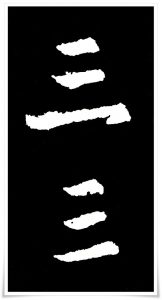
Figure 6. Ink rubbing of semi-cursive (行書, ぎょうしょ, gyōsho) of 三 found in the calligraphy work compilation entitled Ji Wang sheng jiao xu (集王聖教序, pinyin: Jí Wáng shèng jiào xù), created on the order of the Emperor Taizong of Tang (唐太宗, pinyin: Táng Tàizōng), of the Tang dynasty (唐朝, 618 – 907). Characters for this work were chosen from masterpieces of Wang Xizhi (王羲之, pinyin: Wáng Xīzhī, 303 – 361), often referred to as the Sage of Calligraphy (書聖; pinyin: shū shèng), who lived during the Jin dynasty (晉朝, 265 – 420 C.E.).
5. Useful phrases
- 三回 (さんかい, sankai) – three times
- 三分 (さんぷん, sanpun) – three minutes
- 三日 (みっか, mikka) – third day of the month
- 三月 (さんがつ, sangatsu) – March
- 三日月 (みかづき, mikazuki) – crescent moon
